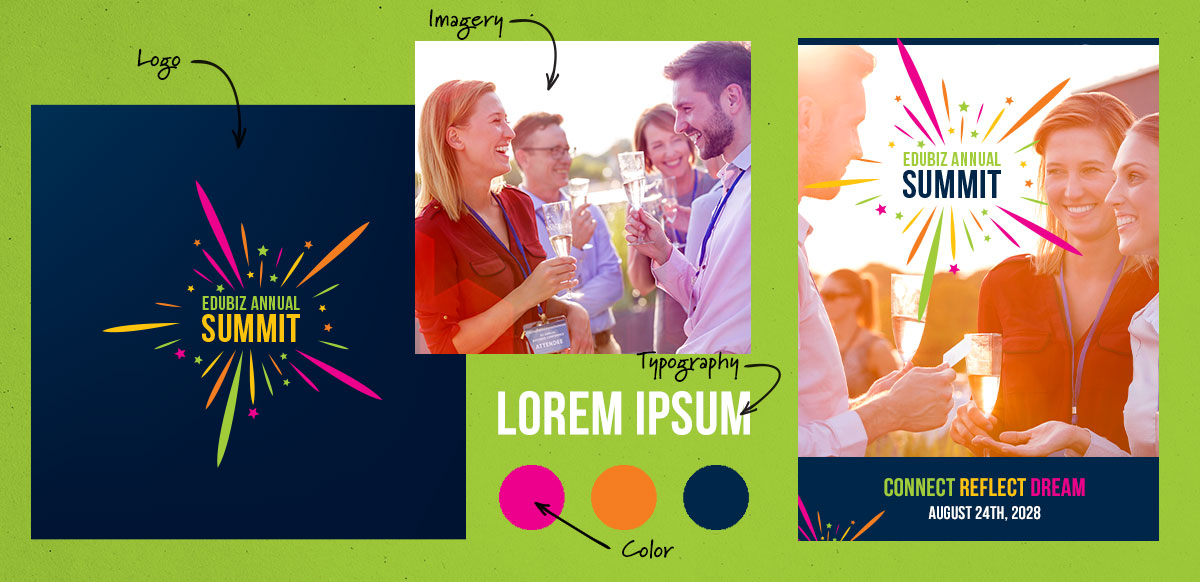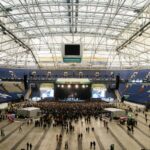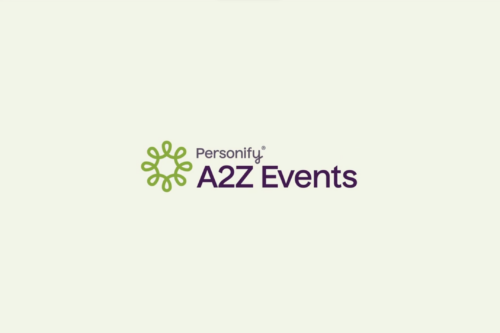Event branding is how you “own” an event.
It’s how you make sure that when an attendee shows up, they know they’re exactly in the right place because all the visual cues align with their expectations.
The goal of event branding is to create a cohesive and distinctive experience reflective of your brand identity throughout your event, as well as before and after.
A strong event branding visual identity can be used year-after-year, just like a company logo and brand identity. The following guide gives you everything you need to know about how to build a memorable event brand.
What is Event Branding?
Event branding refers to the strategic and tactical executions you apply to an experience to best reflect your brand essence to the intended target audience—event attendees.
Simply put, event branding strategy is the marketing practice in which a company or organization creates a distinct name, symbols, colors, messaging, and imagery to uniquely identify an event.
Event branding is most effective when consistently used to promote the event before it happens, be seen on-site at the event, and be infused in all post-event materials as well.
Why is Event Branding Important?
Think of your event as a complete, immersive experience. You’ve undoubtedly lined up captivating speakers, compelling sessions, can’t-miss networking, and engaging entertainment.
But how disappointed would you and your team be if your target audience, no matter how compelling they found your event, couldn’t name you as the event creator?
This is where event branding comes into play. It shapes how your attendees, stakeholders, and sponsors will remember your event and can support your business growth and the long-term appeal of your event marketing.
Guiding Principles of Effective Event Branding
Creating a successful event brand involves more than just eye-catching visuals and clever slogans; it requires a deep understanding of the core principles that make branding effective.
These principles serve as the foundation for every branding decision, guiding how your event is perceived, experienced, and remembered by your audience.
By adhering to these key principles—memorability, cohesiveness, and stakeholder value—you can ensure that your event not only stands out but also leaves a lasting impression that resonates with attendees long after the event concludes.
Let’s explore the essential principles of effective event branding and how they contribute to the overall success of your event.
1. Event Branding Should Be Memorable
To make your event stand out in the mind of your target audience, it must be both memorable and visually compelling. If you succeed with one without the other, you will dilute the potential long-term value of your event and fail to capture the full potential value of a prospect.
2. Event Branding Should Be Cohesive
From the first event announcement to the last piece of swag, all event branding elements should join together to create a cohesive experience. Ensure visual similarity across all touchpoints, as inconsistency can subconsciously detract from the perceived value of your event.
3. Event Branding Delivers Stakeholder Value
With powerful event branding, your most important people will associate your precise value proposition with your event. In the long run, this association can support your business growth, increase Lifetime Customer Value (LTV), and boost brand advocacy.
How to Create a Brand for Your Event
Creating a brand for your event is a crucial step in ensuring its success and making a lasting impression on your attendees.
The process involves more than just designing a logo; it’s about crafting a comprehensive identity that resonates with your target audience and aligns with the overall objectives of your event.
By clearly defining who you’re trying to attract and carefully selecting the visual and tonal elements that will represent your event, you can create a cohesive and compelling brand that not only stands out but also enhances the entire event experience from start to finish.
Define Your Audience
The first and most crucial step in creating a brand for your event is to define your audience. Understanding who you are trying to attract will influence every aspect of your event branding, from the tone of your messaging to the colors you choose. Start by asking yourself some key questions:
Who are the attendees?
Are they senior-level professionals, young creatives, industry experts, or a diverse mix of participants? Knowing the demographic details—such as age, profession, and interests—of your audience will help tailor your branding to their preferences and expectations.
What are their goals?
Consider what your attendees are looking to achieve by attending your event. Are they there to network, learn, or discover new products and services? Understanding their motivations will allow you to create a brand that speaks directly to their needs and desires, making your event more appealing.
What are their pain points?
Identifying the challenges or problems your audience faces will help you position your event as a solution. Your branding can then emphasize how your event will address these pain points, whether through educational sessions, networking opportunities, or access to exclusive content.
How do they perceive your industry or brand?
Understanding your audience’s perception of your industry or brand will help you align your event branding with their expectations. If your audience is looking for innovation and cutting-edge insights, your event branding should reflect that through modern design elements and forward-thinking messaging.
What kind of experience do they expect?
The tone and style of your event—whether it’s formal and sophisticated or casual and fun—should be reflected in your branding. For instance, if your event is aimed at high-level executives, your branding should convey professionalism and exclusivity.
On the other hand, if your event is targeting young creatives, a more playful and vibrant approach might be appropriate.
Why will they choose your event over others?
In a competitive event market, it’s important to differentiate your event from others. By clearly defining your unique value proposition—whether it’s the quality of your speakers, the networking opportunities, or the exclusive content—you can create a brand that stands out and draws in your target audience.
Once you’ve answered these questions, you’ll have a clear understanding of your target audience, which will guide every decision you make in the branding process.
This ensures that your event’s brand not only appeals to the right people but also creates an experience that resonates with them, leading to higher engagement and a more successful event overall.
Event Brand Elements

With a clear understanding of your audience in place, the next step in crafting a powerful event brand is to develop the essential brand elements that will visually and emotionally connect with your attendees.
These elements—ranging from your logo and color scheme to typography and imagery—are the building blocks of your event’s identity.
Each component should be carefully chosen to reflect the essence of your event and to create a consistent and memorable experience across all touchpoints.
In this section, we’ll explore the key elements that make up a strong event brand and how to use them effectively to ensure your event stands out and leaves a lasting impression on your audience.
Create a Toolbox of Brand Elements
Once you’ve defined your audience, you can begin creating your brand elements, including the logo, color scheme, typography, imagery, and voice. Each of these elements should reflect the essence of your event and align with your brand’s visual identity.
Logo
Your event logo is the cornerstone of your event’s visual identity.
It should be simple, legible, and instantly recognizable, ensuring that it communicates your brand at a glance. A well-designed logo is versatile, meaning it can be scaled to fit a variety of contexts—from small digital formats like app buttons and social media icons to large physical displays such as banners and signage.
This adaptability is crucial because your logo needs to maintain its impact and clarity no matter where it appears. Additionally, your logo should encapsulate the essence of your event, making it a visual shorthand for what attendees can expect.
Color
Color is a powerful tool in event branding, capable of evoking emotions and setting the overall tone of your event.
Thoughtful use of color can help you connect with your target audience on a deeper level, as different colors can convey different messages—such as trust, excitement, or sophistication.
Consistency is key; maintaining a uniform color palette across all branding materials not only reinforces your brand identity but also helps in organizing your event visually.
For instance, you might use specific colors to differentiate event segments or tracks, making it easier for attendees to navigate the experience. By carefully selecting and applying your color scheme, you can create a visually cohesive event that resonates with your audience.
Typography
Typography is more than just the style of text you choose—it’s a reflection of your event’s personality. The right font can enhance the clarity of your message and contribute to the overall feel of your event.
For body text and essential information, choose fonts that are clean and easy to read, ensuring that your message is accessible to all attendees. However, don’t be afraid to introduce a “display font” in smaller doses to add character and flair where needed, such as in headlines or promotional materials.
This careful balance between readability and style helps reinforce your event’s brand identity while ensuring that the content remains clear and engaging.
Imagery
The imagery you use plays a significant role in setting the tone and atmosphere of your event. It should not only be visually appealing but also aligned with the overall theme and message of your event. For more serious and formal events, consider using monochromatic tones and restrained imagery that convey professionalism and focus.
Conversely, if your event is playful and energetic, opt for vibrant, high-saturation images that capture the lively spirit of the experience. The way you treat your imagery can dramatically influence how your audience perceives your event, making it an essential element in your branding toolkit.
Voice
The tone of voice you adopt in your event messaging is crucial in establishing a connection with your audience. It should reflect the nature of your event and resonate with the expectations of your attendees.
Whether your event is formal and exclusive, casual and fun, or inspirational and motivational, your voice needs to be consistent across all communications—from marketing materials and social media posts to on-site signage and speaker introductions.
A well-defined tone of voice not only helps to build a unique identity for your event but also ensures that your messaging is clear, engaging, and relatable to your audience.
Implementing Your Event’s Branding
Once you’ve established the foundational elements of your event’s brand, the next critical step is to ensure that this branding is effectively implemented across every aspect of your event.
Consistent and strategic branding should be infused into all touchpoints, from pre-event marketing to the on-site experience and digital interactions. This consistency helps reinforce your brand’s identity, creating a cohesive experience for attendees that resonates before, during, and after the event.
In this section, we’ll explore how to implement your event’s branding across various channels to maximize impact and engagement.
Event Marketing
Marketing is the first point of contact between your event and potential attendees, making it essential that your branding is consistent and compelling across all channels.
From your registration site to promotional emails, social media posts, print ads, and other materials, every piece of content should reflect your brand’s identity. This means using the same logos, colors, fonts, and messaging tone throughout.
Consistent branding in your marketing efforts not only builds anticipation but also ensures that your event is instantly recognizable, reinforcing the connection with your audience from the very beginning.
On-Site Event Branding
On-site branding is where your event’s identity comes to life in a tangible way. Your brand should be prominently displayed across all major elements, such as stage designs, banners, and wayfinding signs, ensuring that the visual experience is aligned with the brand you’ve built.
However, don’t overlook the smaller details—badges, swag, handouts, and even the décor should also carry your brand’s visual elements. This creates a unified environment that immerses attendees in your brand, enhancing their overall experience and making your event memorable.
Digital Branding for Your Event
In today’s digital age, ensuring that your event’s branding extends into the digital realm is crucial. Your event app, website, and other digital assets should consistently reflect your brand’s identity through the use of logos, colors, and fonts.
Additionally, create engaging digital experiences with branded hashtags that can be used across social media before, during, and after the event. These hashtags not only boost engagement but also help create a sense of community among attendees, further solidifying your brand’s presence in their minds.
Pre-Event Engagement
Building excitement before the event is key to driving attendance and setting the stage for a successful experience. Utilize your branding in pre-event communications, such as teaser videos, countdown emails, and social media posts, to build anticipation.
Consider offering branded early-bird incentives or sneak peeks of event highlights to keep your audience engaged. The goal is to create a buzz that not only attracts attendees but also makes them feel connected to your event before it even begins.
Post-Event Follow-Up
Branding doesn’t end when the event does—it extends into the post-event follow-up period, where you can continue to engage attendees and reinforce your event’s impact. Send out branded thank-you emails, surveys, and recap videos that align with the visual and tonal elements of your event.
This not only helps in gathering feedback but also keeps your event top of mind, increasing the likelihood of repeat attendance and long-term loyalty to your brand.
Event Branding Strategies
To make your event truly unforgettable, you need more than just a strong brand identity—you need a strategic approach to ensure that your brand is visible, impactful, and consistent across all channels.
Effective event branding strategies help you reach your target audience, create a lasting impression, and differentiate your event from the competition. In this section, we’ll explore key strategies such as blanket coverage and powerful visuals, and how they can be leveraged to maximize your event’s impact.
These strategies, when applied thoughtfully, will ensure that your event brand resonates with attendees and remains top of mind long after the event ends.
Blanket Coverage: Your Event Appears “Everywhere”
One of the most effective ways to ensure your event stays top of mind is by creating the illusion that your brand is “everywhere.” This can be achieved through targeted campaigns that strategically place your event in front of your audience across multiple platforms and touchpoints.
Whether it’s through digital ads, airport posters, newsletters, or direct mailers, blanket coverage ensures that your audience sees your event consistently and repeatedly, reinforcing brand recognition.
By understanding your audience’s media consumption habits, you can invest in the right channels that will keep your event visible and relevant, leading to higher engagement and attendance.
Powerful Visuals: Your Event Stands Out, Consistently
Visual consistency is crucial for reinforcing your event’s brand identity and ensuring that your audience can immediately recognize and connect with it. This concept, often referred to as “ad scent,” means that every visual element—from ads to landing pages—should be consistent in style, color, typography, and messaging.
This coherence across all touchpoints helps to create a seamless brand experience that strengthens the connection between your marketing efforts and the actual event. When attendees see the same visual cues throughout their journey, it reinforces the event’s identity and makes it more memorable.
Strategic Partnerships: Amplify Your Reach
In addition to blanket coverage and powerful visuals, consider forming strategic partnerships to amplify your event’s reach. Collaborating with industry influencers, media outlets, or complementary brands can help extend your event’s visibility to a broader audience.
These partnerships can take the form of sponsorships, co-branded content, and joint promotions, all of which can provide additional touchpoints for your event branding. By aligning with partners who share your target audience, you can enhance your event’s credibility and attract a larger, more engaged attendee base.
Interactive Experiences: Engage and Retain Attention
Another effective strategy for event branding is creating interactive experiences that actively engage attendees. Whether it’s through live polls, interactive social media campaigns, or immersive on-site activities, these experiences not only captivate your audience but also create opportunities for deeper brand engagement.
By involving attendees in dynamic ways, you not only make the event more memorable but also create positive associations with your brand. These interactive elements can be shared across digital platforms, further extending your event’s reach and impact.
Event Branding Ideas
When it comes to making your event stand out, innovative branding ideas can play a pivotal role in leaving a lasting impression on attendees. These ideas go beyond traditional marketing efforts, offering unique ways to embed your brand into the very fabric of the event experience.
Whether through creative swag, dynamic digital assets, or engaging photo opportunities, these strategies ensure that your brand remains at the forefront of attendees’ minds.
In this section, we’ll explore several impactful event branding ideas that can help elevate your event, boost attendee engagement, and maximize the visibility of your brand before, during, and after the event.
Branded Event Swag
Event swag is more than just a giveaway—it’s an opportunity to reinforce your brand in a memorable and tangible way. High-quality, branded items not only serve as mementos of the event but also keep your brand in front of attendees long after they’ve left.
Consider offering a range of swag, from standard freebies to exclusive VIP items that can be earned through participation, such as product demos or special event activities.
These branded items can include everything from practical items like reusable water bottles or notebooks to trendy apparel or tech gadgets. By carefully selecting swag that aligns with your brand and resonates with your audience, you can create a lasting connection that extends well beyond the event.
Digital Assets
Digital assets are a powerful tool for embedding your brand into every aspect of the event. This includes everything from your event website and app to digital signage, social media content, and even the lighting and floor design at the event venue.
By infusing your event branding into these elements, you create a cohesive digital experience that reinforces your brand identity at every touchpoint. Branded hashtags and social media walls are particularly effective for encouraging attendee engagement, allowing participants to share their experiences in real-time while amplifying your event’s reach across digital platforms.
These digital interactions help create a sense of community among attendees and ensure that your brand is part of the conversation.
Photo Ops
Creating branded photo opportunities is a fun and interactive way to engage attendees while promoting your event. Designate specific spots within your event venue that are ideal for taking photos—these could be areas with striking backdrops, branded props, or creative installations.
Encourage attendees to snap photos and share them on social media using your event’s hashtag. Not only does this provide a memorable experience for attendees, but it also generates user-generated content that extends the reach of your event branding.
Consider offering high-quality photo mementos as swag items or setting up a branded photo booth with props to add an element of fun and creativity to the experience.
Investing in the Pre-Event Excitement
Building excitement before the event is crucial for driving attendance and setting the stage for a successful experience. Pre-event marketing efforts should be infused with your event branding to create a buzz that resonates with your target audience.
This could include teaser videos, countdown campaigns, early-bird promotions, and sneak peeks of what attendees can expect. By creating a sense of anticipation, you ensure that your audience is not only eager to attend but also engaged and invested in the event from the start.
Maintaining this momentum through the event and into post-event follow-ups helps keep your brand top of mind and encourages long-term engagement.
Exclusive Experiences
Adding an element of exclusivity to your event can significantly enhance the attendee experience and reinforce your brand’s value. Consider offering special access to certain areas, VIP lounges, or exclusive meet-and-greet opportunities with keynote speakers.
These exclusive experiences can be branded to reflect the premium nature of the offering, making attendees feel valued and creating a deeper connection to your event. By positioning certain aspects of your event as exclusive, you not only generate buzz and increase demand but also strengthen the overall perception of your brand.
Sealing the Deal: Mastering Event Branding Success
Event branding is much more than just slapping a logo on the top of the event form and offering a cheap t-shirt at registration. It’s a critical component to the success of your event, helping to associate your brand with the positive experiences of your attendees.
Success in event branding requires a strong visual identity, consistent messaging, and the strategic use of brand elements across all touchpoints. Investing time and resources into event branding will not only enhance the attendee experience but also support your business growth and long-term event appeal.
Did you know our event pros spend on average 50 hours per event helping planners like you leverage your event’s brand? Since 1995, we’ve provided the conference and tradeshow industry with innovative technologies designed to improve and simplify event planning, powering more than 12,000 events around the world. Get in touch if you’re looking for on-site or behind-the-scenes help.










